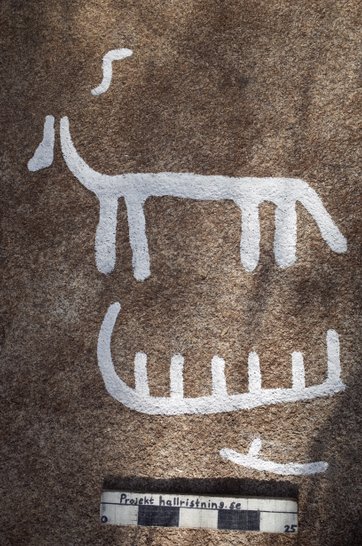2,700-Year-Old Petroglyphs Unearthed on Swedish Island

Approximately 40 ancient rock carvings have been found by researchers on a former rocky island in Sweden. The petroglyphs contain depictions of ships, people, and animals, and are believed to be around 2,700 years old, according to Live Science.
The petroglyphs were chiselled into a high granite cliff, once part of an island. This means that people had to make these carvings while standing in a boat or from a platform built on ice, said Martin Östholm, head of the Foundation for Documentation of Bohuslän's Rock Carvings project, one of the archaeologists who discovered the petroglyphs.
The petroglyphs contain not only images of ships, people, and animals, but also four-legged creatures that may be horses. The largest of the petroglyphs depicts a ship 13 feet (4 meters) long, said Östholm, noting that many of the petroglyphs are smaller, ranging in length from 12 to 16 inches (30-40 centimeters).
According to Östholm, the ancient people used a hard stone to hit the granite cliff to create the petroglyphs. This action exposed a white layer beneath, making the petroglyphs easily visible even from the mainland or passing ships. He stated that it remains unclear why people created these carvings, but speculated that they might have served to mark property rights.
An expert not involved in the discovery also shared some ideas about the significance of these carvings.
If the petroglyphs were made over a relatively short period, they could tell a story, said James Dodd, a researcher at Aarhus University in Denmark and Tanums Hällristningsmuseum Underslös rock art research center in Sweden. Some motifs, including chariots, carts, and animal figures, have been depicted multiple times, he noted.

"Based on the repetition of motifs, it's possible that this collection of figures forms a narrative," Dodd said. Research on other petroglyphs in the region suggested that they may have been used in such a way in some cases, but the exact meaning in this case is undetermined, he added.
The petroglyphs were discovered at the beginning of May, and investigations are ongoing, Östholm said.

Bohuslän is already known for its rock paintings, including Bronze Age artworks in Tanum, a UNESCO World Heritage site. Therefore, the team was looking for new petroglyphs in this area when they stumbled upon a moss-covered cliff. They noticed several lines on it that appeared to be man-made, so they removed the moss, revealing the petroglyphs underneath. The cliff was too steep to stand on, said Östholm, so the team had to stand on a platform to conduct their archaeological work.
